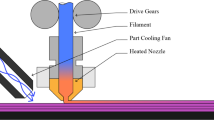Abstract
Surface mount assembly defect problems can cause significant production-time losses. About 60% of surface mount assembly defects can be attributed to the solder paste stencil printing process. This paper proposes a neurofuzzy-based quality-control system for the fine pitch stencil printing process. The neurofuzzy approach is used to model the nonlinear behavior of the stencil printing process. Eight control variables are defined for process planning and control, including stencil thickness, component pitch, aperture area, snap-off height, squeegee speed, squeegee pressure, solder paste viscosity, and solder paste particle size. The response variables are the volume and height of solder paste deposited. The values of the response variables provide indicators for identifying potential quality problems. A 38–3 fractional factorial experimental design is conducted to collect structured data to augment those collected from the production line for neurofuzzy learning and modeling. Visual basic programming language is then used for both rule retrieval and graphical-user-interface modeling. The effectiveness of the proposed system is illustrated through a real-world application.
Similar content being viewed by others
References
Amir, D. (1994) Expert system for SMT assembly. Proceedings of the Surface Mount International Conference and Exposition—Technical Program, pp. 691–699.
Arafeh, L., Singh, H. and Putatunada, S. K. (1999) A neuro fuzzy logic approach to material processing. IEEE Transactions on Systems, Man, and Cybernetics C, 29(3), 362–370.
Bezdek, J. C. (1981) Pattern Recognition with Fuzzy Objective Function Algorithms, Plenum, New York.
Danielson, H. (1995) Surface Mount Technology with Find Pitch Components: The Manufacturing Issues, Chapman and Hall, London.
Franklin, M. F. (1984) Constructing tables of minimum aberration p n-m designs. Technometrics, 26(3), 225–232.
FuzzyTECH user's manual. (1998) Version 5.1, Inform Software Corporation, Aachen, Germany.
He, D., Ekere, N. N. and Currie, M. A. (1998) The behavior of solder pastes in Stencil Printing with Vibrating Squeegee. IEEE Transactions on Components, Packaging, and Manufacturing Technology C, 21(4), 317–324.
Harris, C. J., Brown, M., Bossley, K. M., Mills, D. J. and Ming, F. (1996) Advances in neurofuzzy algorithms for real-time modeling and control. Engineering Application of Artificial Intelligence, 9, 1–16.
Jang, J. R. (1993) ANFIS: adaptive network-based fuzzy inference systems. IEEE Transactions on Systems, Man, and Cybernetics, 23(3), 665–685.
Kosko, B. (1992) Neural Networks and Fuzzy Systems, Prentice Hall, Englewood Cliffs, N.J.
Lau, F. K. H. and Yeung, V. W. S. (1997) A hierarchical evaluation of the solder paste printing process. Materials Processing Technology, 69, 79–89.
Lin, C. T. and Lee, C. S. G. (1996) Neural Fuzzy Systems, Prentice Hall: Englewood Cliffs, N.J.
Lotfi, A. and Howarth, M. (1998) Industrial application of fuzzy systems: adaptive fuzzy control of solder paste stencil printing. Journal of Information Sciences, 107, 273–285.
Lotfi, A. and Tsoi, A. C. (1996) Learning fuzzy inference systems using an adaptive membership function scheme. IEEE Transactions on Systems, Man, and Cybernetics, 26(2), 326–332.
Mannan, S. H., Ekere, N., Ismail, N. I. and Lo, E. K. (1994) Squeegee deformation study in the stencil printing of solder paste. IEEE Transactions on Components, Hybrids, and Manufacturing Technology, 17(3), 470–476.
Markstein, H. W. (1997) Controlling the variables in stencil printing. Electronic Packaging and Production, 37(2), 48–56.
Mashor, M. Y. (2001) Adaptive fuzzy c-mean clustering algorithm for a radial basis function network. International Journal of Systems Science, 32(1), 53–63.
Pan, J. (2000) Modeling and process optimization of solder past stencil printing for Micro-BGA and fine pitch surface mount assembly, Ph.D. Dissertation, Lehigh University, Bethlehem, PA.
Pan, J., Tonkay, G. L., Storer, R. H., Sallade, R. M. and Leandri, D. J. (1999) Critical variables of solder paste stencil printing for micro-BGA and fine pitch QFP. Proceedings of IEEE/CPMT International Electronics Manufacturing Technology Symposium, pp. 94–101.
Ries, B. (2000) Inspection strategies for process control. Circuits Assembly, March.
Tsoukalas, L. H. and Uhrig, R. E. (1997) Fuzzy and Neural Approaches in Engineering, John Wiley and Sons, N.Y.
Zadeh, L. (1965) Fuzzy sets. Information Control, 8(3), 338–353.
Author information
Authors and Affiliations
Corresponding author
Rights and permissions
About this article
Cite this article
Yang, T., Tsai, TN. A neurofuzzy-based quality-control system for fine pitch stencil printing process in surface mount assembly. Journal of Intelligent Manufacturing 15, 711–721 (2004). https://doi.org/10.1023/B:JIMS.0000037719.35871.aa
Issue Date:
DOI: https://doi.org/10.1023/B:JIMS.0000037719.35871.aa




